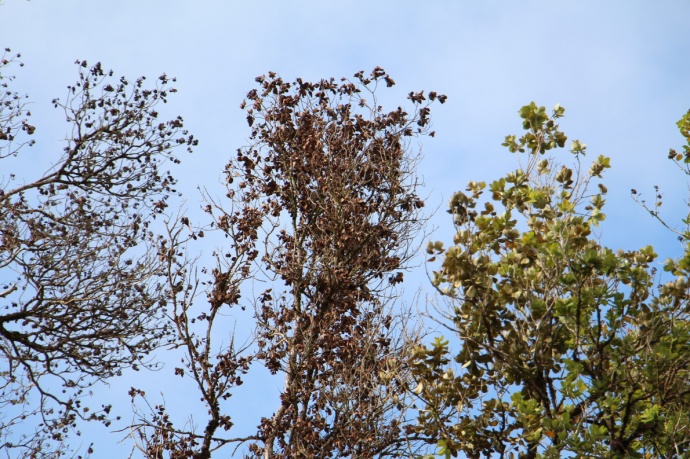Emergency Quarantine Placed on Movement of ʻŌhiʻa from Hawaiʻi Island
By Maui Now Staff
The state Board of Agriculture approved an interim rule that restricts the movement of ʻōhiʻa plants and plant parts, including ʻōhiʻa flowers, from the Big Island of Hawaiʻi.
The rule was approved today and places a strict quarantine on the intrastate movement of the plant. This includes its flowers, leaves, seeds, stems, twigs, cuttings, untreated wood, logs, mulch greenwaste and frass (sawdust from boring beetles).
The interim rule will go into effect within 12 days when it is published in newspapers, and will remain in effect for one year.
State agricultural officials say the reason for the emergency quarantine measure is ʻōhiʻa wilt, also known as rapid ʻōhiʻa death, a deadly fungus that is attacking ʻōhiʻa trees in East Hawaiʻi Island.
In addition to the quarantine restriction, the interim rule will also restrict the movement of soil from Hawaiʻi Island beginning in January 2016. State agricultural officials say island nurseries were concerned that a restriction on soil from Hawaiʻi Island would hurt agricultural businesses. “Although the spores of the disease is found in soil, the delay was imposed to further research whether soil is able to transmit the disease and to develop testing protocols and treatment options for soil,” agricultural officials said in today’s announcement.
Timeline of ʻōhiʻa wilt discovery & spread:
- According to officials with the state Department of Agriculture, ʻōhiʻa wilt was first noticed in 2010 in Puna.
- In 2014, the fungus was identified as Ceratocystis fimbriata by researchers at the US Department of Agriculture’s Daniel K Inouye Agricultural Research Service.
- In 2014, it was estimated that the disease covered approximately 6,000 acres from Kalapana to Hilo and exhibited tree mortality rates of more than 50%.
- Currently, it is estimated to infest about 15,000 acres. So far, the disease has not been found on other islands. It is not known how the disease entered the state or where it came from.
How is it spread:
“We don’t have all the answers about how the disease is transmitted,” said Scott Enright, Chairperson of the Hawaiʻi Board of Agriculture. “However, the urgency to stop its spread is very clear. ʻŌhiʻa makes up 50% of our native forests and watershed – resources that we just cannot risk losing,” Enright said in a department press release.
State officials say it is suspected that the fungus enters the plants through wounds. It causes the crowns of the ʻōhiʻa to turn yellow and brown within days to weeks followed by the death of the tree. The fungus also causes dark, nearly black, staining in the sapwood along the outer margins of the trunks.
Penalty for violation of interim rule:
Any person who violates the rule may be charged with a misdemeanor and fined not less than $100, with a maximum fine being $10,000, agricultural officials said. For a second offense committed within five years of a prior conviction, the person or organization shall be fined not less than $500 and not more than $25,000.
Authorities say the interim rules will give the department time to develop more permanent rules.











